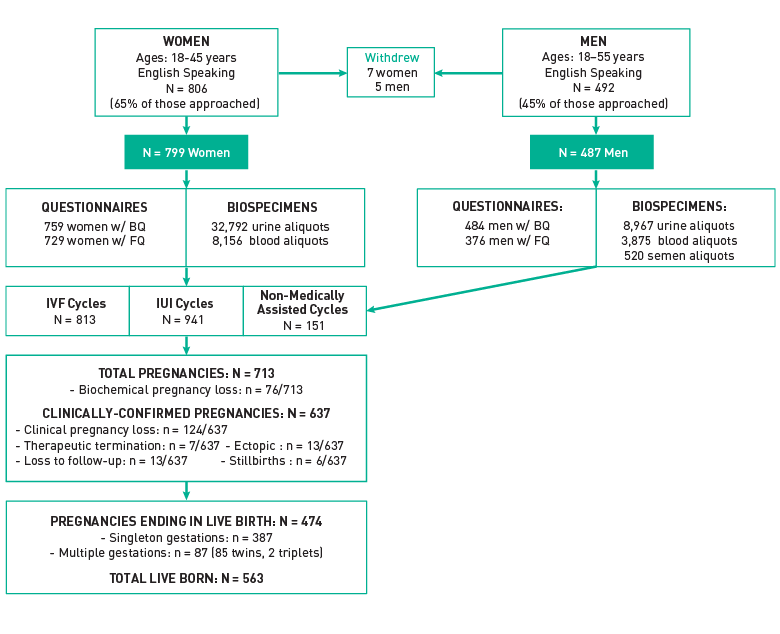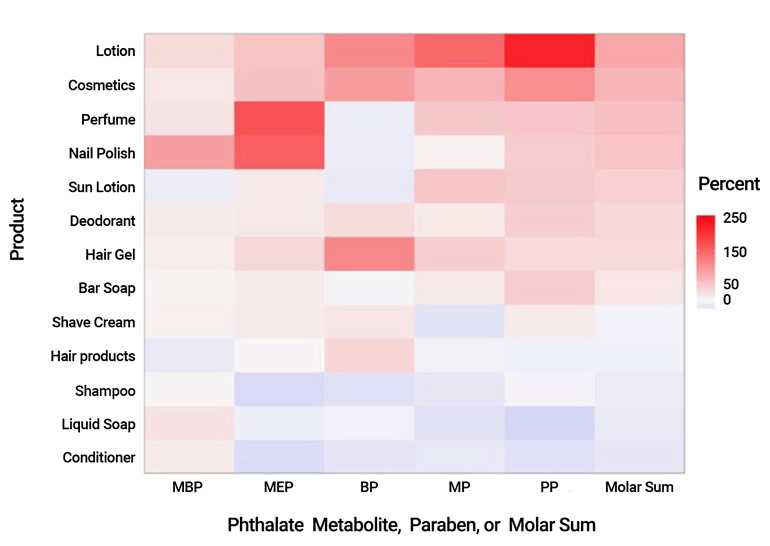The EARTH Study: Examining the Impact of Environment, Diet and Lifestyle on Human Reproduction
In This Article
- A fertility clinic setting supports an unusually rich data set by providing access to women, men and their children from preconception through childhood
- The EARTH Study is the largest of its kind, investigating the impact of more than 50 biomarkers on reproductive health through almost 20 years of continuous NIH funding
- Specific environmental exposures and components of diet impacted the chances of reproductive success for both men and women
To better understand human fertility, no data point is too small. Researchers in the Environment and Reproductive Health (EARTH) Study, one of the most comprehensive studies of environmental and chemical exposure effects on reproductive health, know this well. The team logs data on gametes and collects prenatal, perinatal and postnatal data from mothers, fathers and neonates—and now will follow the children born of enrolled parents to age 12.
Subscribe to the latest updates from OB/GYN Advances in Motion
This groundbreaking work is the product of a collaborative research initiative by the Massachusetts General Hospital Fertility Center, the Harvard T.H. Chan School of Public Health and Harvard Medical School. A summary of the research being done through the EARTH Study and its findings since 2004 was recently published in Human Reproduction Open.
The importance of the EARTH Study is evidenced by its productive longevity—almost 20 years of continuous National Institutes of Health (NIH) funding and an extensive record of publications. The study has analyzed more than 50 biomarkers of chemical and environmental exposure effects on pregnancy, birth and childhood, and continues to search for answers to questions about infertility and adverse pregnancy outcomes.

Fig. 1: Earth Study Participant Flow Chart
Between 2004 and 2017, 799 women and 487 men have participated in the EARTH Study, resulting in a rich data set for the research team. BQ = Baseline Questionnaire; FQ = Full Questionnaire. Source: Human Reproduction Open, February 2018
Getting a Complete Picture
Most studies of environmental effects on fertility recruit only the mother during pregnancy, and then look only for reproductive outcomes and assess the children's health.
"Our study is unique in that we recruit both the man and the woman, and we recruit them pre-conception," says lead researcher Russ Hauser, MD, ScD, MPH, chair of the Department of Environmental Health at Harvard's T.H. Chan School of Public Health and professor of obstetrics, gynecology and reproductive biology at Harvard Medical School.
Dr. Hauser adds, "If you don't recruit as early as we do, you are missing the very early development window and missing completely any of the father's contributions."
His colleague and co-investigator, John Petrozza, MD, director of the Fertility Center, agrees. "Having data from the patient or couple going through infertility treatment really enhances the power and impact of our research. This data can help individuals make decisions about limiting exposures to some chemicals if they have concerns, for example, reducing plastic packaging, consumption of foods from metal cans, pesticide residues on fruits and vegetables," he says. "It's very hard for individuals to make those kind of choices without research like ours."
EARTH collaborator Irene C. Souter, MD, director of the Fertility Center's Preimplantation Genetic Diagnostics Program, emphasizes the study's potential to help advance public education on pre-conception health care to minimize genetic risks.
“Emerging evidence suggests that environmental exposures during the peri-conception, prenatal, neonatal and postnatal periods may permanently reprogram the physiology of the offspring through epigenetic modifications that lead to changes in the human genome stored in the DNA,” says Dr. Souter. “Since these epigenetic modifications lead to heritable changes in the gene function, they may be passed on and adversely affect the function of multiple reproductive organs in future generations.”
Fertility Center Recruitment Advantage
Conducting a study within the context of a fertility clinic ensures access to a large, high-quality sample of motivated patients who keep appointments and comply with directions as they struggle for a year or more to conceive and deliver a child.
Working with these patients allows for consistent data gathering from both men and women for a variety of factors, including:
- Mercury concentration in hair
- Biomarkers of exposure to certain chemicals, including phthalates from vinyl plastics and personal care products, phenols such as Bisphenol A (BPA) from food can linings and flame retardants used in furniture foam
- Follicular fluid from women and semen from men
- DNA methylation and small RNAs
Potential Impacts of the EARTH Study
Data from the EARTH Study has impacts beyond the clinical realm. Study findings have helped organizations such as the U.S. Environmental Protection Agency and the Consumer Product Safety Commission make decisions about the registration and use of chemicals that the general population is exposed to.
"Some of our research is cited in relationship to trying to restrict the use of phthalates (chemicals that make plastics flexible) in personal care and consumer products," Dr. Hauser says.
One of the best examples of the public health impact of EARTH research comes from the reaction to Bisphenol A. "Bisphenol A is a common chemical in plastic production. It’s found in polycarbonate plastics, hospital equipment and tubing and the lining of food cans, just to name a few examples,” says Dr. Petrozza. "As we began to publish our data, people started to look at bisphenol A as a real health concern."
This groundbreaking work set the foundation for looking at the issue of BPA and other plastics more carefully. "Ultimately, it led to discussions at a national level, followed by bans of certain BPA products," Dr. Petrozza says. "This ultimately led to people realizing the negative effects of BPA, forcing the plastics industry to eliminate BPA as much as they could.”
Summary of Key Findings
In investigating the impact of environmental exposures, diet and lifestyle on reproductive health and pregnancy, the research team found that, in general, exposure to some environmental chemicals in both men and women was associated with reduced fertility and a higher risk of adverse outcomes—though some dietary factors improved the probability of successful reproductive outcomes.
Study findings recently published in Human Reproduction Open and other journals include:
- Some phthalates and other environmental chemicals, such as flame retardants, were associated with pregnancy loss
- Eating fruit and vegetables with high pesticide residue was linked to lower fertility
- Caffeine negatively affected men, but not women, in successful reproductive outcomes
- Women doing jobs that involved heavy lifting were found to have a lower chance of successful pregnancy

Fig. 2a: Comprehensive Data & Analysis
Heatmaps show adjusted percent change in urinary concentrations of phthalate metabolites and parabens associated with use of certain personal care products in the previous 24 hours. Data shows concentrations of various substances among from female participants who had a live birth in the EARTH Study. Source: Human Reproduction Open, February 2018

Fig. 2b: Comprehensive Data & Analysis
Data in heatmap shows data from male participants. Source: Human Reproduction Open, February 2018
Next Steps
While the EARTH Study has made great strides, there is still work to be done, and the team continues to expand their outlook. "There are a lot of intriguing animal studies in which investigators manipulate diet or induce stress in the male and see effects in the offspring. Now one of our focus areas is paternal exposures and their contributions to a child’s health," says Dr. Petrozza.
"Moving this field of inquiry from animal studies to humans is one of our goals," says Dr. Hauser.
To accomplish this, the EARTH team recently received NIH funding to enroll approximately 300 children ages 6-12 from their previous participants in a follow-up study. This new work will support more detailed analysis of how a child's health is impacted by the mother's and father's environmental exposures, diets and lifestyles. Children's neurobehaviors and their metabolic health are key outcomes of interest.
“Since the accumulating evidence strongly suggests that environmental exposures can influence reproductive outcomes, it is important to elucidate the mechanisms mediating adverse changes and identify the target sites through which they act,” says Dr. Souter. “Future studies should focus on the potential impact of environmental chemicals on the gonads, the gametes, embryonic development, implantation and early placentation.”
“Through this work,” she says, “we hope to minimize adverse exposures and improve reproductive outcomes for the generations to come.”
Learn more about the Fertility Center
Learn more about fertility research at Mass General